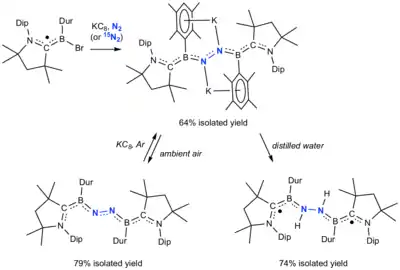Abiological nitrogen fixation using homogeneous catalysts
Abiological nitrogen fixation describes chemical processes that fix (react with) N2, usually with the goal of generating ammonia. The dominant technology for abiological nitrogen fixation is the Haber process, which uses an iron-based heterogeneous catalysts and H2 to convert N2 to NH3. This article focuses on homogeneous (soluble) catalysts for the same or similar conversions.[1]

Transition metals

3_complexes.svg.png.webp)


Vol'pin and Shur
An early influential discovery of abiological nitrogen fixation was made by Vol'pin and co-workers in Russia in 1970. Aspects are described in an early review:
"using a non-protic Lewis acid, aluminium tribromide, were able to demonstrate the truly catalytic effect of titanium by treating dinitrogen with a mixture of titanium tetrachloride, metallic aluminium, and aluminium tribromide at 50 °C, either in the absence or in the presence of a solvent, e.g. benzene. As much as 200 mol of ammonia per mol of TiCl
4 was obtained after hydrolysis.…"[3]
These results led to many studies on dinitrogen complexes of titanium and zirconium.[4]
Mo- and Fe-based systems
Because Mo and Fe are found at the active site of the most common and most active form of nitrogenase, these metals have been the focus of particular attention for homogeneous catalysis. Most catalytic systems operate according to the following stoichiometry:
- N2 + 6 H+ + 6 e− → 2 NH3
The reductive protonation of metal dinitrogen complexes was popularized by Chatt and coworkers, using Mo(N2)2(dppe)2 as substrate. Treatment of this complex with acid gave substantial amounts of ammonium.[3] This work revealed the existence of several intermediates, including hydrazido complexes (Mo=N-NH2). Catalysis was not demonstrated. Schrock developed a related system based on the amido Mo(III) ocomplex Mo[(HIPTN)3N]. With this complex, catalytic nitrogen fixation occurred, albeit with only a few turnovers.[2]
Intense effort has focussed on family of pincer ligand-supported Mo(0)-N2 complexes. In terms of it donor set, and oxidation state, these pincer complexes are similar to Chatt's complexes. Their advantage is that they catalyze the hydrogenation of dinitrogen. A Mo-PCP (PCP = phosphine-[[NHC]-phosphine]] complex exhibits >1000 turnovers when the reducing agent is samarium(II) iodide and the proton source is methanol.[1][5]
Iron complexes of N2 are numerous. Derivatives of Fe(0) with C3-symmetric ligands catalyze nitrogen fixation.[1]
p-Block systems
Although nitrogen fixation is usually associated with transition metal complexes, a boron-based system has been described. One molecule of dinitrogen is bound by two transient Lewis-base-stabilized borylene species.[11] The resulting dianion was subsequently oxidized to a neutral compound, and reduced using water.
Nitriding
In rare cases, metals react with nitrogen gas to give nitrides, a process called nitriding. For example, metallic lithium burns in an atmosphere of nitrogen, giving lithium nitride. Hydrolysis of the resulting nitride gives ammonia. In a related process, trimethylsilyl chloride, lithium and nitrogen react in the presence of a catalyst to give tris(trimethylsilyl)amine, which can be further elaborated.[12] Processes involving lithium metal are however of little practical interest since they are non-catalytic and re-reducing the Li+
ion residue is difficult.
Some Mo(III) complexes also cleave N2:[13]
- 2 Mo(NR2)3 + N2 → 2 N≡Mo(NR2)3
This and related terminal nitrido complexes have been used to make nitriles.[14]
See also
- Nitrogenase: enzymes used by organisms to fix nitrogen
- Transition metal dinitrogen complex
- Metal nitrido complex
References
- Chalkley, Matthew J.; Drover, Marcus W.; Peters, Jonas C. (2020). "Catalytic N2-to-NH3 (Or -N2H4) Conversion by Well-Defined Molecular Coordination Complexes". Chemical Reviews. 120 (12): 5582–5636. doi:10.1021/acs.chemrev.9b00638. PMC 7493999. PMID 32352271.
- Schrock, Richard R. (2006). "Reduction of Dinitrogen" (PDF). PNAS. 103 (46): 17087. Bibcode:2006PNAS..10317087S. doi:10.1073/pnas.0603633103. PMC 1859893. PMID 17088548.
- Chatt, J.; Leigh, G. J. (1972). "Nitrogen Fixation". Chem. Soc. Rev. 1: 121. doi:10.1039/cs9720100121.
- Chirik, Paul J. (2010). "Group 4 Transition Metal Sandwich Complexes: Still Fresh after Almost 60 Years". Organometallics. 29 (7): 1500–1517. doi:10.1021/om100016p.
- Arashiba, Kazuya; Miyake, Yoshihiro; Nishibayashi, Yoshiaki (2011). "A molybdenum complex bearing PNP-type pincer ligands leads to the catalytic reduction of dinitrogen into ammonia". Nature Chemistry. 3 (2): 120–125. Bibcode:2011NatCh...3..120A. doi:10.1038/nchem.906. PMID 21258384.
- Rebreyend, C.; de Bruin, B. (2014). "Photolytic N
2 Splitting: A Road to Sustainable NH
3 Production?". Angew. Chem. Int. Ed. 54 (1): 42–44. doi:10.1002/anie.201409727. PMID 25382116. - Solari, E.; Da Silva, C.; Iacono, B.; Hesschenbrouck, J.; Rizzoli, C.; Scopelliti, R.; Floriani, C. (2001). "Photochemical Activation of the N≡N Bond in a Dimolybdenum–Dinitrogen Complex: Formation of a Molybdenum Nitride". Angew. Chem. Int. Ed. 40 (20): 3907–3909. doi:10.1002/1521-3773(20011015)40:20<3907::AID-ANIE3907>3.0.CO;2-#. PMID 29712125.
- Huss, Adam S.; Curley, John J.; Cummins, Christopher C.; Blank, David A. (2013). "Relaxation and Dissociation Following Photoexcitation of the (μ-N
2)[Mo(N[t-Bu]Ar)3]2 Dinitrogen Cleavage Intermediate". J. Phys. Chem. B. 117 (5): 1429–1436. doi:10.1021/jp310122x. PMID 23249096. - Kunkely, H.; Vogler, A. (2010). "Photolysis of Aqueous [(NH
3)5Os(μ-N
2)Os(NH
3)5]5+: Cleavage of Dinitrogen by an Intramolecular Photoredox Reaction". Angew. Chem. Int. Ed. 49 (9): 1591–1593. doi:10.1002/anie.200905026. PMID 20135653. - Miyazaki, T.; Tanaka, H.; Tanabe, Y.; Yuki, M.; Nakajima, K.; Yoshizawa, K.; Nishibayashi, Y. (2014). "Cleavage and Formation of Molecular Dinitrogen in a Single System Assisted by Molybdenum Complexes Bearing Ferrocenyldiphosphine". Angew. Chem. Int. Ed. 53 (43): 11488–11492. doi:10.1002/anie.201405673. PMID 25214300.
- Broere, Daniël L. J.; Holland, Patrick L. (2018-02-23). "Boron compounds tackle dinitrogen". Science. 359 (6378): 871. Bibcode:2018Sci...359..871B. doi:10.1126/science.aar7395. ISSN 0036-8075. PMC 6101238. PMID 29472470.
- Brook, Michael A. (2000). Silicon in Organic, Organometallic, and Polymer Chemistry. New York: John Wiley & Sons, Inc. pp. 193–194.
- Laplaza, Catalina E.; Johnson, Marc J. A.; Peters, Jonas C.; Odom, Aaron L.; Kim, Esther; Cummins, Christopher C.; George, Graham N.; Pickering, Ingrid J. (1996). "Dinitrogen Cleavage by Three-Coordinate Molybdenum(III) Complexes: Mechanistic and Structural Data1". Journal of the American Chemical Society. 118 (36): 8623–8638. doi:10.1021/ja960574x.
- Curley, John J.; Sceats, Emma L.; Cummins, Christopher C. (2006). "A Cycle for Organic Nitrile Synthesis via Dinitrogen Cleavage". J. Am. Chem. Soc. 128 (43): 14036–14037. doi:10.1021/ja066090a. PMID 17061880.